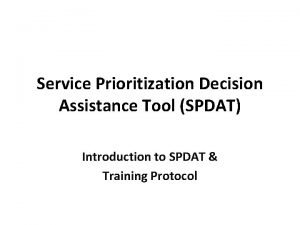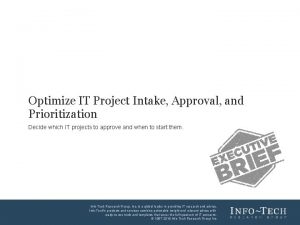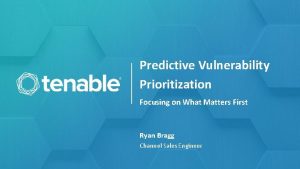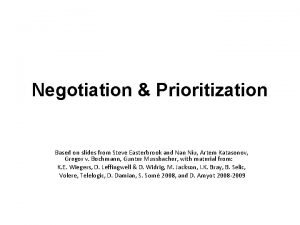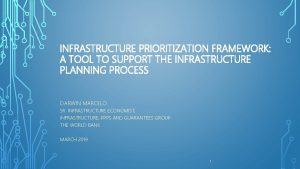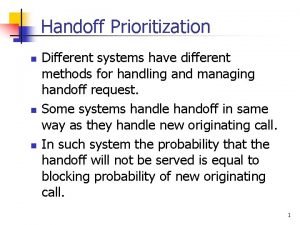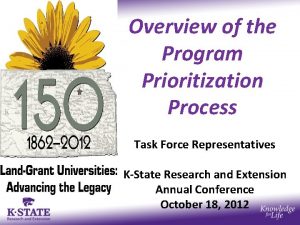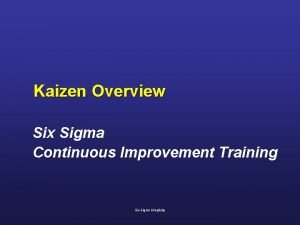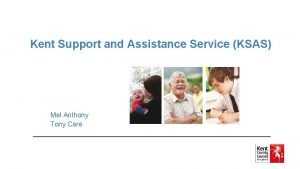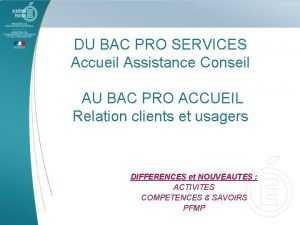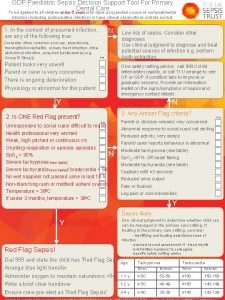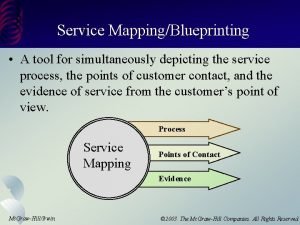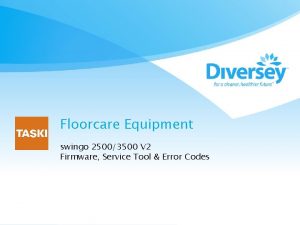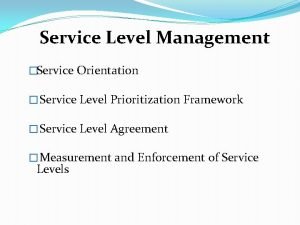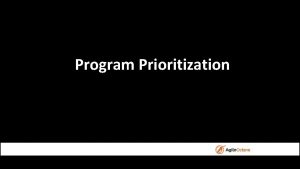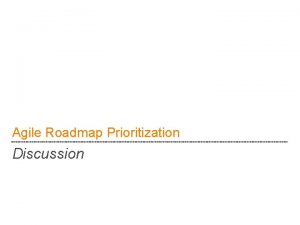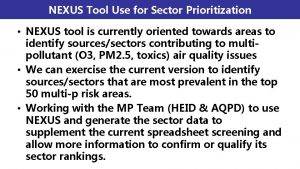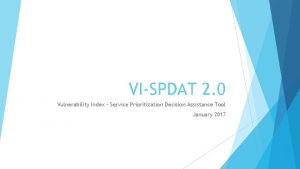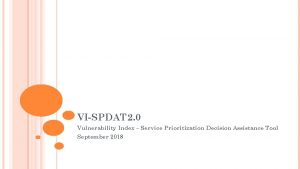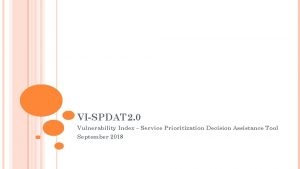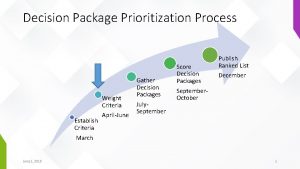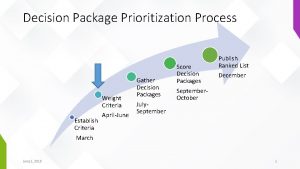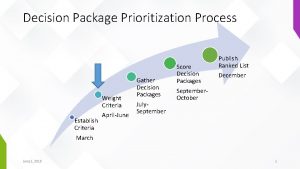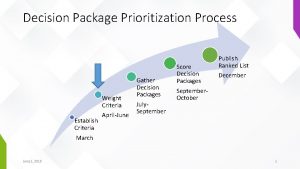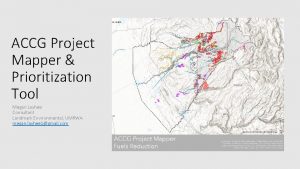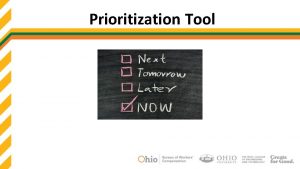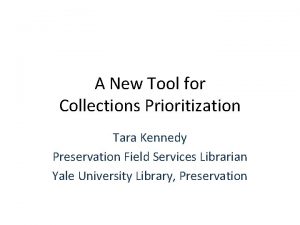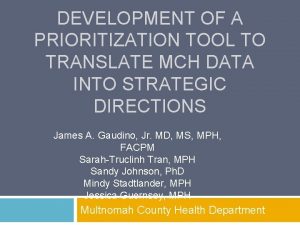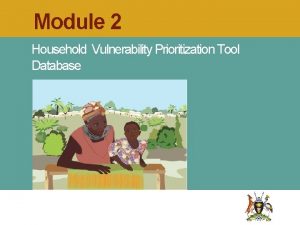Service Prioritization Decision Assistance Tool SPDAT Introduction to


























- Slides: 26

Service Prioritization Decision Assistance Tool (SPDAT) Introduction to SPDAT & Training Protocol

Part I 1. 2. 3. 4. 5. What is SPDAT? SPDAT Types? Why Use SPDAT? What SPDAT doesn’t do? Common Questions?

SPDAT What is SPDAT? • A system-wide tool needed to help guide the right household to the right support intervention to end homelessness. • Moves away from “first come, first serve” or luck of the service delivery system. • Helps you understand the depth of the issues and which household is most likely to benefit from which type of housing support intervention.

SPDAT Types: • VI (Vulnerability Index) SPDAT – is a prescreening to the full SPDAT for a homeless individual. • F-VI (Family Vulnerability Index) SPDAT – is a prescreening to the full Family SPDAT.

Full SPDAT (Very different from the VI SPDAT) SPDAT Types: • SPDAT – is the full SPDAT to be used for a homeless individual. • F (Family) SPDAT – the family SPDAT examines the entire homeless family unit. • Youth – comparing youth to youth works. (When youth are compared to adults, you are disadvantaged. )

SPDAT VI & Full SPDAT are entered on the Homeless Management Information System (HMIS)

SPDAT VI or Full SPDAT? • VI SPDAT used at shelters to capture underlying issues. Tells if you need a full SPDAT. • Full SPDAT at HARA’s to qualify households for deep resources such as Rapid Re-housing or Permanent Housing.

SPDAT Why use SPDAT? • It is an objective tool. • It helps you understand the depth of the issues. • It prioritizes who will get served first based upon acuity. • It provides a structural frame.

SPDAT Why use SPDAT? • It provides a baseline • It increases housing stability • It helps prioritize time and resources • SPDAT is grounded in research and evidence a decade worth of research and testing went into SPDAT.

SPDAT Why use SPDAT? • The SPDAT prioritizes which clients receive what type of housing assistance intervention and assist in determining the intensity of case management services • Matches clients to frontline workers and service priorities • Guides frontline workers and team leaders for an intensive case management approach to service delivery

SPDAT Why use SPDAT? • SPDAT use is required for Housing Assessment and Resource Agencies (HARAs) and shelters receiving funds from DHHS, MSHDA, and/or HUD.

SPDAT What the SPDAT doesn’t do: - Provide a diagnosis - Predict an index for future risk - Take the place of other valid, reliable instruments in clinical research and care - Doesn’t say if a person meets program requirements

SPDAT What the SPDAT doesn’t do: - Provide a diagnosis - Predict an index for future risk - Take the place of other valid, reliable instruments in clinical research and care - Doesn’t say if a person meets program requirements

SPDAT Is SPDAT just for homeless people? • No. While it will identify which households have higher acuity, the tool also identifies which households have moderate acuity. It identifies those households that do not need your precious resources to get out of homelessness.

SPDAT Common questions: Q: Do you need to ask the questions verbatim? A: Yes; however, you may ask them in a different format/order if approved by your agency. Q: What do you do when a client answers: “I don’t know” to a question? A: Ask probing questions to see if you can him/her out.

SPDAT – Part II Case Managers Operational Assumptions: • Your job is to get people housed and keep them housed. • You do not heal or fix people, but you • Believe in hope – are a “positive change agent. ” • Use assessments to guide opportunities for coaching & support – not to focus on barriers.

SPDAT Case Manager Operational Assumptions: • Case worker does the hard support, and the client does the hard work. • Clients can and should be respectfully challenged to change. • Proactive planning support beat reactionary crisis responses.

SPDAT Case Manager Operational Assumptions: • People can and do recover. • Housing stability is your primary objective. • Your work is guided by evidence.

SPDAT Case Manager Operational Assumptions: • Each person seeking support assistance and housing has a different story & circumstances. • Each person is unique. • Each person as strengths to build off & the case manger needs to acknowledge strengths to gain trust, respect, and leverage.

SPDAT Case Manager must: • Seek to understand high acuity to decrease those areas of risks. • Let people know supports are available. • Never complete a SPDAT without person knowing that the assessment is occurring. • Explain the SPDAT & offer a copy of the summary sheet.

SPDAT Case Manager must: • Let the client know that a copy of the summary sheet goes in their file and/or information get into HMIS

SPDAT Progress Engagement & Eligibility Screening • If your program has a checklist to qualify, the assessors/case managers should do that before completing the full SPDAT, i. e. , if they do not qualify for reasons such a income or other program requirements, there is no need to do the full SPDAT.

SPDAT Progress Engagement & Eligibility Screening • If your program has a checklist to qualify, the assessors/case managers should do that before completing the full SPDAT, i. e. , if they do not qualify for reasons such a income or other program requirements, there is no need to do the full SPDAT.

SPDAT Progressive Engagement and Eligibility Screening: • Explain programs that people qualify for prior to doing a full SPDAT. • Explain the acuity score – the higher the acuity, the more intensive the support program. Be truthful, e. g. , “you scored very high in a number of components and a more intensive type of support will increase you being successfully housed long-term. ”

SPDAT – Training Protocols Training Schedule • Will your Co. C have a Single trainer or will you have Co-trainers? • As a trainer(s) how often will you meet with your SPDAT users? • How will training be provided for new users?

SPDAT – Training Protocols • Best Practices recommend that each community/Co. C have a trainer that trains new, incoming staff on use of VI & full SPDAT to ensure accurate assessment and that important “buy-in” from staff of different service providers.
 What is spdat
What is spdat Objectives of decision making
Objectives of decision making Slidetodoc.com
Slidetodoc.com Individual assistance payment
Individual assistance payment Project intake process presentation
Project intake process presentation Rpa prioritization matrix
Rpa prioritization matrix Vulnerability
Vulnerability Volere prioritization
Volere prioritization Problems with wsjf
Problems with wsjf Prioritization
Prioritization Risk prioritization in software engineering
Risk prioritization in software engineering Abcd prioritization nursing
Abcd prioritization nursing Infrastructure project prioritisation matrix
Infrastructure project prioritisation matrix Prioritization
Prioritization Ticket prioritization
Ticket prioritization Program prioritization process
Program prioritization process 1 improvement per day
1 improvement per day Kent support and assistance
Kent support and assistance Navigational assistance service
Navigational assistance service Bac pro services accueil assistance conseil
Bac pro services accueil assistance conseil Decision table and decision tree examples
Decision table and decision tree examples Gdp sepsis decision support tool
Gdp sepsis decision support tool Lung cancer screening shared decision making tool
Lung cancer screening shared decision making tool Potter's wheel data cleaning tool
Potter's wheel data cleaning tool Microsoft decision service
Microsoft decision service A tool for simultaneously depicting the service process
A tool for simultaneously depicting the service process Taski service tool download
Taski service tool download
